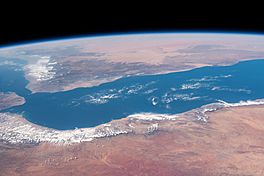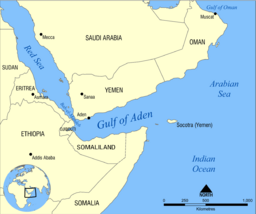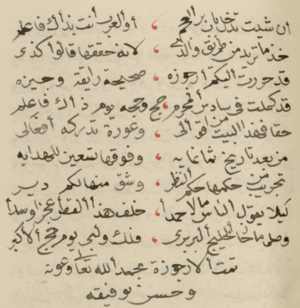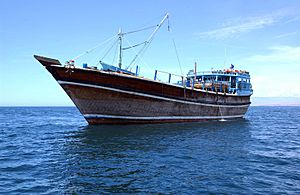Gulf of Aden facts for kids
Quick facts for kids Gulf of Aden |
|
|---|---|
 |
|

The Gulf of Aden, as viewed from space (top) and on a map (bottom)
|
|
| Location | East Africa and West Asia |
| Coordinates | 12°N 48°E / 12°N 48°E |
| Type | Gulf |
| Basin countries | |
| Surface area | 410,000 km2 (160,000 sq mi) |
| Average depth | 500 m (1,600 ft) |
| Max. depth | 2,700 m (8,900 ft) |
| Max. temperature | 28 °C (82 °F) |
| Min. temperature | 15 °C (59 °F) |
| Settlements | Aden, Mukalla, Balhaf, Zeila, Berbera, Maydh, Las Khorey, Djibouti, Berbera, Bosaso |
The Gulf of Aden (Arabic: خليج عدن, Somali: Gacanka Cadmeed 𐒅𐒖𐒐𐒕𐒌 𐒋𐒖𐒆𐒗𐒒) is a large gulf, which is a part of the Indian Ocean. It is located between Yemen in the north and Somalia in the south. To its west is Djibouti, and to its east is the Arabian Sea.
This gulf is very important for ships. It connects the Red Sea through a narrow passage called the Bab-el-Mandeb strait. This strait is part of a major shipping route that links the Mediterranean Sea to the Indian Ocean via the Suez Canal. Thousands of ships use this route every year. Many of these ships carry oil from the Persian Gulf, making the Gulf of Aden a key part of the world economy.
The land around the Gulf of Aden became mostly Muslim a long time ago. In the 1960s, the Soviet Navy started to have a bigger presence here. The gulf's importance changed when the Suez Canal was closed. But it became very important again when the canal reopened in 1975 after being made deeper and wider.
Important cities along the gulf include Aden in Yemen. Other cities are Djibouti in Djibouti, and Berbera and Bosaso in Somalia. Even though there aren't many big fishing companies, many small towns and villages along the coast rely on fishing. The gulf is full of fish, turtles, and lobsters. Local fishermen catch sardines, tuna, and mackerel.
Contents
A Look at History: How the Gulf Got Its Name

Long ago, the ancient Greeks thought of the Gulf of Aden as part of the Erythraean Sea. This was their name for the Red Sea and nearby waters. The Greeks even named some islands in the gulf, but we don't know which ones today.
Later, in the medieval period, some maps and writings called it the Gulf of Berbera. This shows how important the city of Berbera was for trade back then. A famous sailor named Ibn Majid also used this name in his book about sailing in the 15th century. Berbera has been a busy port for a very long time.
Geography of the Gulf
The Gulf of Aden is a deep body of water. In the middle of the gulf, there's something called the Aden Ridge. This is where the Earth's plates are slowly moving apart. Because of this, the gulf is actually getting wider by about 15 millimeters (about half an inch) each year!
Where the Gulf Begins and Ends
The International Hydrographic Organization helps define the exact borders of oceans and seas. They describe the Gulf of Aden's limits like this:
- To the west: It connects to the Red Sea. The line is between Hisn Murad and Ras Siyyan.
- Further west: It narrows into the Gulf of Tadjoura. The line is between Obock and Lawyacado.
- To the east: It opens up into the Arabian Sea.
Water Conditions
The water temperature in the Gulf of Aden changes with the seasons. It can be as cool as 15 °C (59 °F) or as warm as 28 °C (82 °F). This depends on the time of year and when the monsoon winds blow. The saltiness of the water also varies. It's usually around 35.3 parts per thousand along the Somali coast. But it can be as high as 37.3 parts per thousand in the middle of the gulf.
Exclusive Economic Zones
Countries have special areas of the sea near their coasts called "exclusive economic zones" (EEZ). In these zones, they have special rights to explore and use marine resources. Here are the sizes of the EEZs for the countries bordering the Gulf of Aden:
| Number | Country | Area (Km2) |
|---|---|---|
| 1 | 509,240 | |
| 2 | 831,059 | |
| 3 | 7,037 | |
| Total | Gulf of Aden | 1,347,336 |
The Gulf's Economy and Trade

The Gulf of Aden is a very important waterway for shipping. About 11% of the world's oil that travels by sea passes through here. This oil is on its way to the Suez Canal or to oil refineries nearby.
Many important ports are located along the gulf. These include Aden, Balhaf, and Mukalla in Yemen. In Djibouti, there is Djibouti City. And in Somaliland and Somalia, you'll find ports like Zeila, Berbera, and Bosaso.
Long ago, the gulf was a busy place for international trade. Ships carried goods between Egypt and Rome in the west, and Classical India and China in the east. People traded things like incense and tortoiseshell.
Over time, trade routes changed. This led to more piracy in the area. A book from the 1st century, Periplus of the Erythraean Sea, tells about an Egyptian captain's experiences during this time.
In the late 2000s, there were many pirate attacks in the gulf. But by 2013, these attacks had greatly decreased. This was thanks to private security and international navies patrolling the waters. Countries like India send warships to protect trade in this important area.
Marine Life and Environment
The Gulf of Aden is a relatively new body of water in terms of geology. It has a special variety of living things, known as biodiversity. You can find many kinds of fish, coral, seabirds, and other sea creatures here.
For a long time, this rich natural environment was not heavily polluted. However, environmental groups are worried. They fear that without a plan to control pollution, the gulf's unique ecosystem could be in danger.
Large sea animals like whales, dolphins, and dugongs used to be common. But their numbers dropped a lot because of commercial hunting in the 1960s and 70s. Today, only a few large whales are seen in the gulf. These include critically endangered Arabian humpback whales, Bryde's whales, and blue whales. Deep-sea whales like sperm whales also live here.
See also
 In Spanish: Golfo de Adén para niños
In Spanish: Golfo de Adén para niños
- Maritime Security Patrol Area
- International fleet of vessels in the Gulf of Aden

